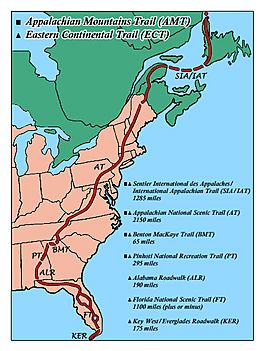International Appalachian Trail facts for kids
Quick facts for kids International Appalachian Trail |
|
|---|---|

This map does not show trails through Nova Scotia or Prince Edward Island nor the more recent additions on the eastern side of the Atlantic.
|
|
| Length | 1,900 mi (3,100 km) |
| Location | Maine, United States, and Canada |
| Trailheads | Mount Katahdin – Belle Isle |
| Use | Hiking |
| Highest point | Mount Katahdin |
| Lowest point | Cap Gaspé |
The International Appalachian Trail (IAT; French: Sentier international des Appalaches, SIA) was originally a continuous hiking trail which ran from the northern terminus of the Appalachian Trail at Mount Katahdin, Maine, through New Brunswick, to the Gaspé Peninsula of Quebec, after which it followed a ferry route to Newfoundland, and then continued to the northern-easternmost point of the Appalachian Mountains at Belle Isle, Newfoundland and Labrador.
It was originally described as an extension of the iconic Appalachian Trail in the United States. That characterization was abandoned after objections from officials of the Appalachian Trail Conference, the legal administrators of the Appalachian Trail, although the name International Appalachian Trail was kept.
In 2009, IAT officials met with the British Geological Survey in Scotland to discuss whether to extend the IAT to the Appalachian terrains of Scotland, Ireland, Northern Ireland, and Wales, setting off a series of expansions through Europe and Northern Africa in which existing trails co-branded with the IAT.
As of July 2020, there are widely geographically dispersed IAT-branded walking trails in Greenland, Iceland, Norway, Sweden, Denmark, Scotland, Northern Ireland, Ireland, Isle of Man, Wales, England, Norway, Spain, Portugal, and Morocco.
History
The IAT was proposed in 1994 by Richard Anderson, a Maine fisheries biologist, with plans to traverse the portions of the Appalachian Mountains in Maine, New Brunswick, and Quebec that the Appalachian Trail did not cover. Following route selection, construction of the trail took place through the late 1990s.
The first person to thruhike the IAT, as it then existed, was John Brinda from Washington State, in 1997. He did this as part of a long-distance hike of what is known as the Eastern Continental Trail starting in Key West, Florida ending at Cap Gaspe in Quebec. He was the first person to thruhike the entire Eastern Continental Trail.
The Newfoundland and Labrador extension to the IAT was proposed in 2003 and is still under construction. When completed, it will add an additional 1,200 km of trail. The official opening of the first trail section of the IAT Newfoundland was September 23, 2006.
Route
The IAT extends northeast from the northern terminus of the Appalachian Trail at Katahdin, Maine to Mars Hill, Maine, before following the U.S.-Canada border north to Fort Fairfield, Maine, where it crosses the border into Perth-Andover, New Brunswick. It continues up the Tobique River valley to Mount Carleton before crossing the Miramichi Highlands to the Restigouche River valley in Quebec and along the Chic-Choc Mountains of the Gaspé Peninsula, ending at the peninsula's easternmost point, Cap Gaspé in Forillon National Park.
From Cap Gaspé, the IAT skips to a small section in Prince Edward Island, Nova Scotia, and over the Gulf of St. Lawrence to Newfoundland, where the trail picks up again at Channel-Port aux Basques and follows the west coast of the island up the Great Northern Peninsula before terminating at the island's northernmost tip, Cape Bauld. From there the IAT skips over the Strait of Belle Isle to the northern terminus of the Appalachian Mountain chain at Belle Isle.
Extension to Europe and North Africa
Geological evidence shows that the Appalachian Mountains, certain mountains of Western Europe, and the Anti-Atlas range in North Africa are parts of the ancient Central Pangean Mountains, made when minor supercontinents collided to form the supercontinent Pangaea more than 250 million years ago. With the break-up of Pangaea, sections of the former range remained with the continents as they drifted to their present locations. Inspired by this evidence, efforts are being made to extend the IAT into Western Europe and North Africa.
In April 2010 Greenland became the seventh chapter of the International Appalachian Trail. The route is on the Nuussuaq Peninsula near Uummannaq Fjord.
Greenland was followed by Scotland in June 2010, when the West Highland Way became the first IAT trail in Europe.
In October 2010 nine new chapters joined the IAT at a meeting in Aviemore, Scotland. The meeting was attended by the IAT President and representatives from Coast Alive, the British Geological Survey, Visit Scotland, and Fáilte Ireland. The new chapters include Norway, Sweden, Denmark, the Netherlands, England, Ulster-Ireland, Wales, the Faroe Islands, and Iceland. The Ulster-Ireland chapter covers territories of both the Republic of Ireland and Northern Ireland.
Spain also joined the IAT in 2010.
Highlights
Parks along the IAT include:
Canada
- Mount Carleton Provincial Park (New Brunswick)
- Gaspésie National Park (Quebec)
- Forillon National Park (Quebec)
- Sir Richard Squires Provincial Park (Newfoundland)
- Ship's Arm Provincial Park (Newfoundland)
- Gros Morne National Park (Newfoundland)
Europe
- The Giant's Causeway, Northern Ireland
- Pembrokeshire Coast National Park, Wales
- Loch Lomond and The Trossachs National Park, Scotland


